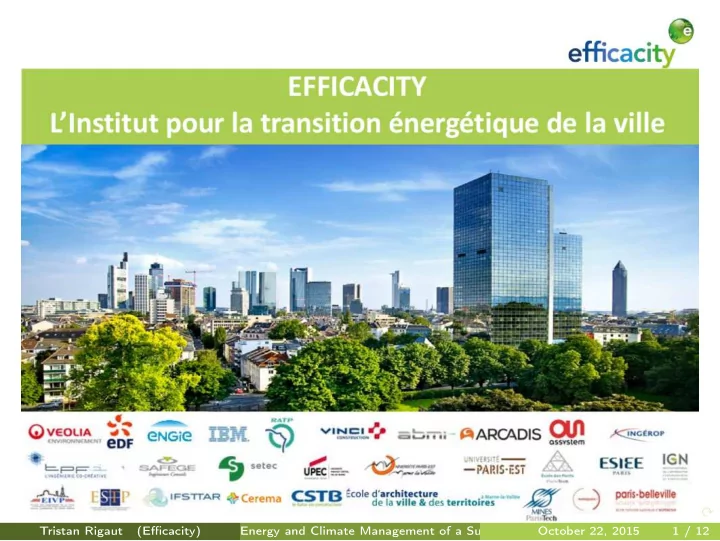

Tristan Rigaut (Efficacity) Energy and Climate Management of a Subway Station October 22, 2015 1 / 12
Energy and Climate Management of a Subway Station Tristan Rigaut 1 1 Pôle Gare, Lot 1 Efficacity, Institute for the Energy Transition October 22, 2015 Tristan Rigaut (Efficacity) Energy and Climate Management of a Subway Station October 22, 2015 2 / 12
Outline A subway station microgrid 1 A subway station Microgrid Dynamic modelling of the station 2 Supply/demand balance Particles dynamics Battery dynamics Economic criterion Optimization of the energy and climate management 3 Results Tristan Rigaut (Efficacity) Energy and Climate Management of a Subway Station October 22, 2015 3 / 12
Subway stations potential energetic flows Tristan Rigaut (Efficacity) Energy and Climate Management of a Subway Station October 22, 2015 4 / 12
A subway station Microgrid Tristan Rigaut (Efficacity) Energy and Climate Management of a Subway Station October 22, 2015 5 / 12
Supply/Demand balance Over τ = 24 hours we have to ensure : P G ( t ) + P Train ( t ) = P L ( t ) + P V ( t ) + P H ( t ) + P B ( t ) � �� � � �� � � �� � � �� � � �� � � �� � Main Grid Power Brakes Power Lights, Elevators Ventilation Heating Battery Tristan Rigaut (Efficacity) Energy and Climate Management of a Subway Station October 22, 2015 6 / 12
Particles Dynamics We have to ensure the occupants safety regarding air quality : Q PM min < Q PM ( t ) < Q PM max Knowing the PM10 dynamics : Fan Air Flow Zone Volume dQ PM ���� � �� � ( t ) = r v P V ( t ) ( Q PM e ( t ) − Q PM ( t )) + V z Q PM Brakes ( t ) V z dt � �� � � �� � � �� � Ventilation Braking Emissions Particulate Matters Dynamics Tristan Rigaut (Efficacity) Energy and Climate Management of a Subway Station October 22, 2015 7 / 12
Battery Dynamics We can control the battery knowing its dynamic : Charge/Discharge Efficiency ���� dS OC ρ B ( t ) = P B ( t ) × dt V 0 Q max � �� � � �� � Charge/Discharge Power Tension × Maximum Charge Which are valid between bounds that ensure good ageing of the battery S OC min ≤ S OC ( t ) ≤ S OC max Tristan Rigaut (Efficacity) Energy and Climate Management of a Subway Station October 22, 2015 8 / 12
Economic criterion Here is the criterion : Total cost of consumed electricity � �� � � τ J ( u ( . )) = C ( t ) P G ( t ) dt × ���� � �� � 0 Main Grid Power Cost (€/ Watt) Tristan Rigaut (Efficacity) Energy and Climate Management of a Subway Station October 22, 2015 9 / 12
No battery vs. Battery controlled We could save 55% of money everyday with a battery Tristan Rigaut (Efficacity) Energy and Climate Management of a Subway Station October 22, 2015 10 / 12
Current air quality vs. Ventilation controlled air quality We could save 45% of money everyday with a proper control of ventilation. Tristan Rigaut (Efficacity) Energy and Climate Management of a Subway Station October 22, 2015 11 / 12
Perspectives Tristan Rigaut (Efficacity) Energy and Climate Management of a Subway Station October 22, 2015 12 / 12
Recommend
More recommend